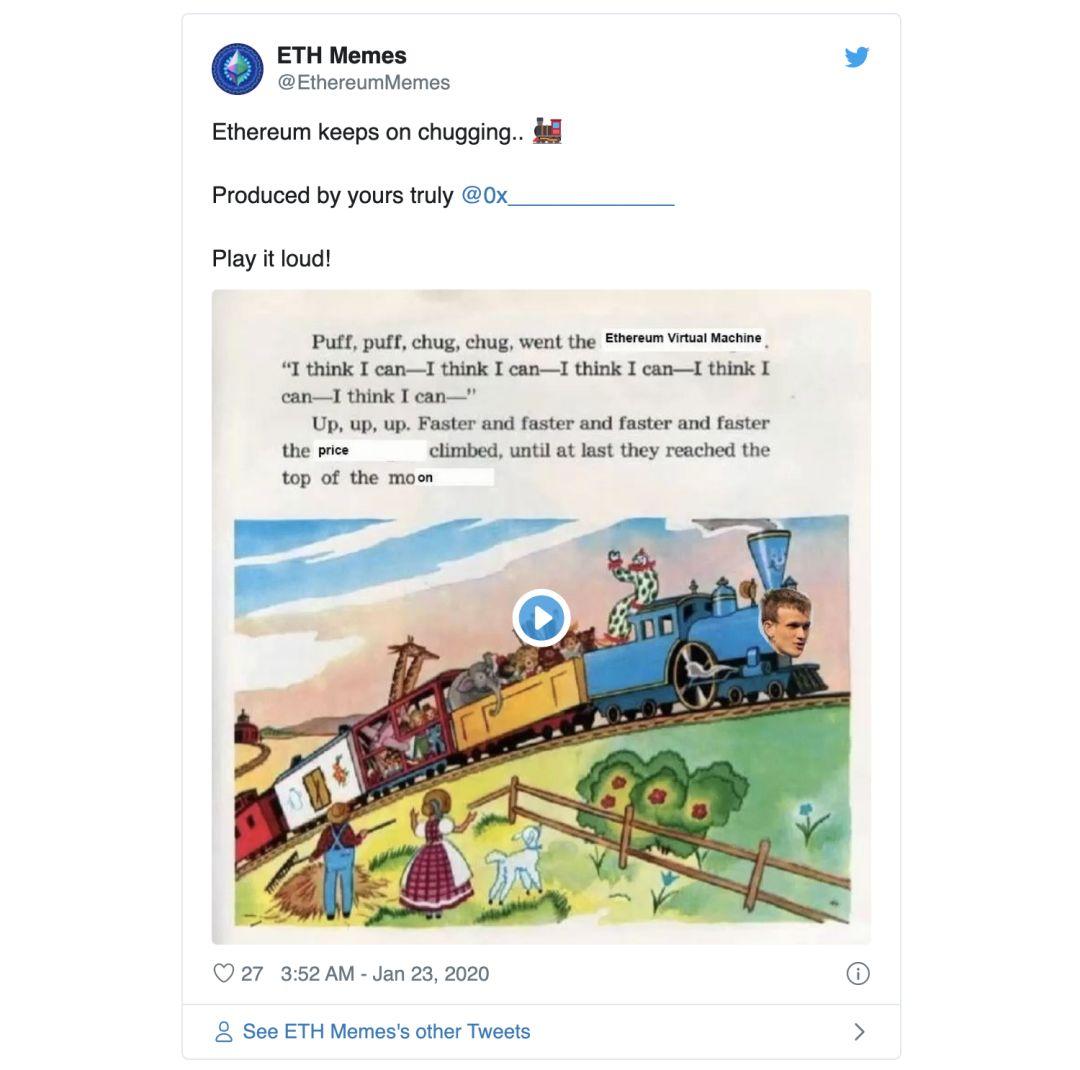Interpretation | Five Misunderstandings of Ethereum 2.0
Source of this article: Chain News
Written by Trenton Van Epps
Translation: Lu Jiangfei
 The picture above is probably your expression: a confused look
The picture above is probably your expression: a confused look
- Opinion: DeFi attack stems from "centralization of rights" and is a pain in growth, not a "knell"
- Perspective | How to prevent censorship attacks on smart contracts?
- Online! Wanxiang blockchain public welfare hackathon, waiting for you to solve these real post-epidemic social needs together
You already know that Ethereum 2.0 (hereinafter referred to as "ETH2") will be launched this year. Maybe you've seen a lot of speeches from Devcon V at the Ethereum Conference, or watched the new testnet block browser created by Etherscan , Bitfly or Alethio . Yes, Eth2 is starting!
However, as the bear market for cryptocurrencies has faded, a number of misconceptions have surfaced. I collected some of the most common misunderstandings, as well as related backgrounds, did some corrections, and provided some resources.
These misreads mainly include:
- "Eth2 will never start";
- "Eth1 will be deprecated immediately after upgrading to Eth2";
- "There will be two ETH tokens after the fork";
- "All decisions in Eth2 are made by Vitalik Buterin alone";
- "Eth2 is a complete solution to the many challenges Eth1 faces."
Misunderstanding 1: "Eth2 will never start"
According to every indicator we have, Eth2 will be launched in 2020 . The code for the deposit contract has just passed formal verification by Runtime Verification, which means that the code can be deployed on the mainnet. Ethereum 2.0 clients such as Prysm , Lighthouse, and Nimbus have been iterating on longer-running testnets , and will switch to mainnet specifications recently.
Every week, people can see innovative client optimization, a larger test network, and a community of stakers growing.
Ethereum has come a long way since restructuring in mid-2018, but the timetable has been set. The most optimistic estimate for client developers is that Phase 0 will be launched in the summer of 2020:
- Attestant.io stated in the article "sometime in the second or third quarter"
- Paul Hauner guest at Into the Ether Podcast mentions "just mid-year" at 43 points
Keep an eye on Danny Ryan's " Eth2 Quick update " or Ben Edgington's " What's New in Eth2 " to track possible launch dates.
- eth2 Quick update
- What's New in Eth2
Misunderstanding 2: "Eth1 will be deprecated immediately after upgrading to Eth2"
Eth1 will coexist with Eth2 for at least a short period of time, after which the two protocols will merge. The merger includes the historical state of the blockchain , the DeFi applications built on it , and all your NFT (non-interchangeable tokens) encrypted artwork.
 What is the situation of the asset confluence, the above picture gives a staged scenario
What is the situation of the asset confluence, the above picture gives a staged scenario
Eth2 has been split into several phases. During these phases of research, development, and deployment, Eth1 will be cheerfully running in the background. However, as each phase reaches maturity and deployment is complete, at some point in time, the state of Eth1 will be fully integrated into the Eth2 system. Ethresear.ch has some of the latest proposals on how to achieve this, such as: " Alternative Proposals for Early ETH1 <-> ETH2 Merger ".
Eth1 will be fully integrated into Eth2 only after a thorough study of all options and weighing their pros and cons. This is also a reasonable and safe way to think. In contrast, some people try to compress the timetable for a certain switching time, which is not good.
There are many benefits to a phased implementation: First, encapsulating the code into discrete modules can better implement risk management. Researchers, client deployers, and auditors can easily analyze the protocol architecture with a management-friendly evaluation method. Second, this way, research, deployment, and testnets can be advanced in parallel, so that the community-oriented mainnet can Faster startup.
In fact, we have already seen the benefits of this approach: Prysmatic Labs and Lighthouse both have a phase 0 public testnet , and phase 1 and phase 2 research is also underway.
Misunderstanding 3: "There will be two ETH tokens after the fork"
In the long run, there will only be one asset in the end. All ETH in circulation today will eventually exist on Eth2 as a "first class citizen". As mentioned above, once Eth2 is stable enough and the combination of the two protocols is ready, the confluence of the two will always happen someday.
Most ordinary users don't need to worry, and don't be tempted to buy any tokens like "ETH 2". In a recent Eth2 AMA Q & A, Vitalik Buterin summed it up nicely:
"If you are just holding ETH now and want to keep your money, then, with all the current proposals, you will not be at risk of getting into trouble in the next five years."
Some people believe that the Ethereum network upgrade means that two tokens will coexist. Most " hard forks " are network upgrades, and as a result, developers generally get better functionality or mitigate attack vectors. Occasionally, there are controversial forks that split the community and sometimes lead to the continued coexistence of two crypto assets. The most famous example is the hard fork that happened in 2016 , and the community split into two camps, Ethereum and Ethereum Classic .
However, the transition from Eth 1 to Eth 2 will not lead to a similar split, because Proof of Stake (PoS) and sharding have been expected from a very early age:
- Proof of Stake: How I Learned to Love Weak Subjectivity (2014)
- On Settlement Finality (2015) mentions sharding as a possible path
The most critical part is that there are some minor issues during the transition period after the beacon chain is launched but before Eth 1 is integrated. During this period, ETH (referring to assets) will perform similar functions, but will be divided into two domains. Over time, they will eventually merge into the same interchangeable market.
The following is a rough sketch of the underlying asset transition:
- Over the next few months, audited deposit contracts will be deployed on the Eth 1 mainnet. Potential Eth2 pledgers (stakers) are looking forward to the launch of " stage 0 " (beacon chain) and will deposit Ether . These ETH will be locked and cannot be removed from the contract;
- At some point thereafter, "stage 0" was officially launched, and depositors became "pledgers": they participated in verifying the blockchain and received returns from newly issued tokens on Eth 2;
- " Stage 1.5 " refers to a mechanism that makes Eth1 a shard, which can avoid some of the more complex trade-off problems that will be caused by some final tool (Eth2 lends security to Eth 1) ) Or a two-way bridge (transfer of assets between ETH's PoW and PoS chain) . A stateless model serving this process is now under study.
Before Eth 1 and Eth 2 are fully integrated, third-party institutions (exchanges or pledge service providers) may create derivatives and IOUs to promote ETH liquidity, as some ETH is pledged and some are temporarily insufficiently liquid. However, third parties create derivatives of real ETH, not real ETH. Considering various difficulties and the need for trust, how this will develop and how large it will be remains to be seen.
Misunderstanding 4: "All decisions in Eth2 are made by Vitalik Buterin alone"
Vitalik Buterin is indeed a key figure, but to advance the project, Ethereum has many researchers and contributors. For example , Danny Ryan has played a very important coordinator role, bridging the gap between researchers and client implementers. Over the past year, the participating teams have been expanding to include the following groups:
- Core research team of the Ethereum Foundation
- 8 active client implementation teams
- Quilt team
- Ewasm team
- TxRx Research
- Stateless Ethereum Research
- Robust Incentives Group
 The picture above shows some ETH 2 implementers who attended the Ethereum Interoperability Conference on September 19, 2019. There is no Vitalik. Photo: Danny Ryan
The picture above shows some ETH 2 implementers who attended the Ethereum Interoperability Conference on September 19, 2019. There is no Vitalik. Photo: Danny Ryan
There are about 75 major developers at this stage, and the team of individual contributors is also expanding. The Ethereum protocol developer Ben Edgington described this well in an article about Eth2 published late last year:
"In fact, as a developer community, we try to operate as openly as possible, such as developer conference calls , communication issues on GitHub , formal upgrades, informal upgrades, and many other channels to encourage participation. Everyone is welcome to participate, There are indeed many people involved. We support organic growth, and we are careful not to allow too much control to either party. To a certain extent, we operate in a manner similar to Linux , which has dominated the global computing field. status."
In the words of another Lutheran co-founder , Joe Lubin :
If Vitalik Buterin takes a break … the Ethereum machine will still be running .

Myth 5: "Eth2 is a complete solution to the many challenges Eth1 faces"
Eth1 has brought to the forefront important issues that are at the forefront of distributed systems, trustless applications, and community centripetal issues. Eth2 will bring many benefits, but the license-free public chain still faces a series of similar challenges. Whether it is 1.0, 2.0, or even 3.0 version. So the community still needs to pay close attention to the following aspects:
- Developer experience: For the builder, please make the transition from Eth 1 to Eth 2 as smooth as possible. Is there any best way to ensure that developers have tools to create and innovate continuously? Be sure to fund infrastructure on Gitcoin !
- Network upgrade (fork coordination) : This requires community members to participate consistently, and they must have the knowledge and promise to make the network upgrade a reality. At least in the beginning, Eth2 will have a hard fork, and this fork and continuous improvement path need to be managed. Of course, these will gradually stabilize over time.
- Community cohesion: The community is not a whole, and each part has its own preferences. Which Ethereum Improvement Proposal (EIP) should be included? Where should resources be invested? This is all part of the collaborative community maintenance work, and is where Ethereum lives.
- Smart contract security: Whether you like it or not, smart contracts written by people will have flaws. eWASM is expected to allow other languages to be used in the Ethereum Virtual Machine (EVM) , but it also means that better framework practices are needed to address this wider area.
- Onboarding : The community, in terms of expansion, and how powerful the protocols it fosters, depend on its ability to provide core updates. Therefore, organizations such as ETHGlobal may need to expand the relevant mandates.
- DApp user interface: What can we learn from end users? We need to continue pushing unmanaged products so that they can introduce new users. Eth2 introduced the finality of the protocol, but this will have little effect on most end users.
- Sustainability of public goods: Funding builders remains important. Eth2 needs a mechanism that can support all implementation teams, perhaps through voluntary client fees. Please support open source projects on Gitcoin!
In fact, these are just a few of the challenges ahead. Maintenance work is not sexy, and it is essential to continuously address all issues that hinder community cohesion . In other words: the Ethereum community needs to weave an ideal model of how to create and maintain an extremely license-free infrastructure that serves value delivery. Most importantly, remember that it is people who are building these protocols.
Watching Eth2 take shape is a fascinating process and I look forward to what will happen in the coming months. I can't include all the misconceptions in this short list, so I will continue this topic. Am I missing something? Please suggest me: @trent_vanepps.
Thanks to Meeseeksing, Justin Leroux, Danny Ryan, Evan Van Ness, and Anthony Sassano for their review and feedback.
We will continue to update Blocking; if you have any questions or suggestions, please contact us!
Was this article helpful?
93 out of 132 found this helpful
Related articles
- Bitcoin developer: 21 million supply cap is a "religious" belief, we may implement a hard fork of inflation
- Read the Bitcoin Lightning Network Mechanism, Progress and Challenges in One Article
- Application of DAO: DAO of Art
- Bitcoin's Secret History: How Much Bitcoin Satoshi has
- bZx revelation: What should Oracle oracles need for DeFi?
- Analysis report check the latest chip distribution of major currencies
- New indicators added to technical analysis? Twitter can also predict coin prices and transaction volumes






